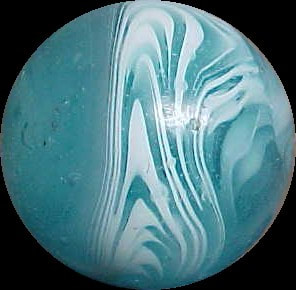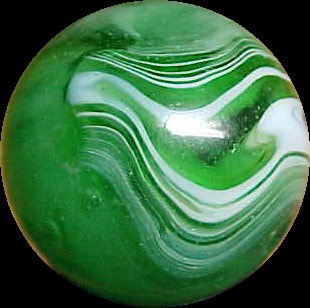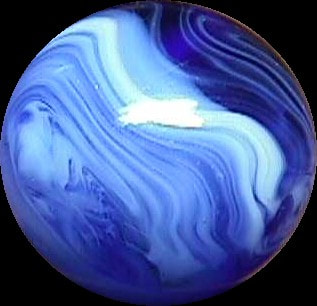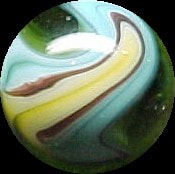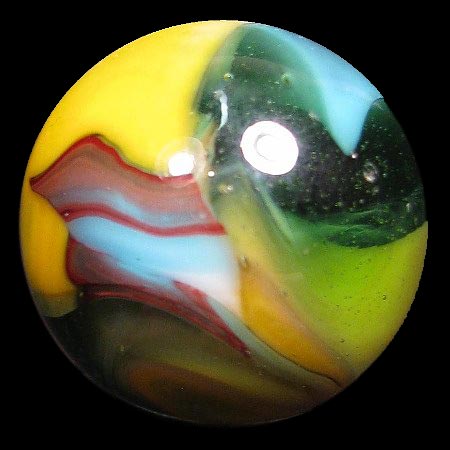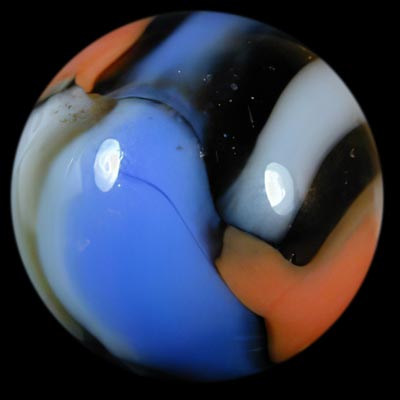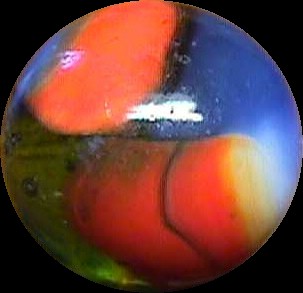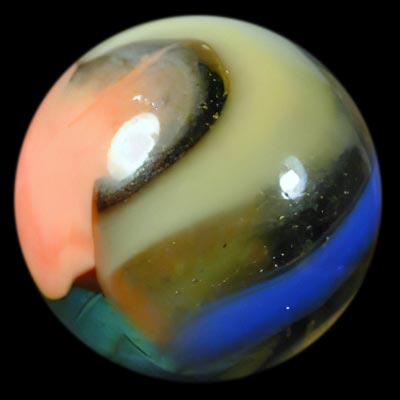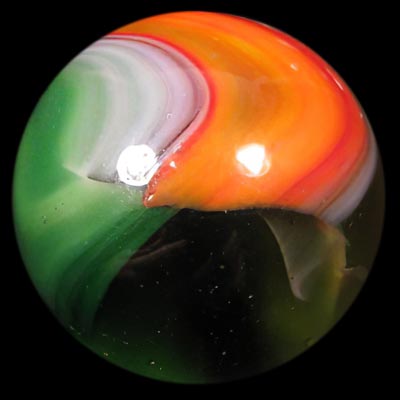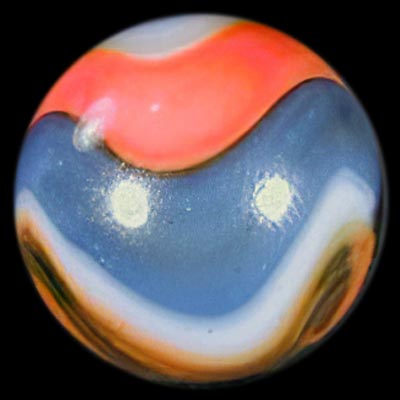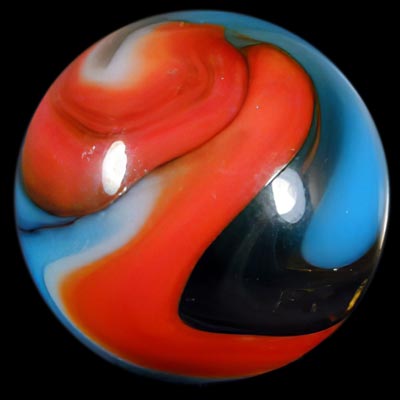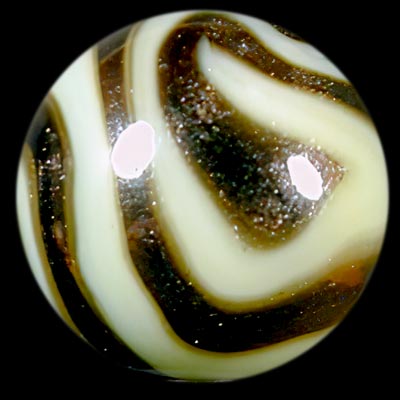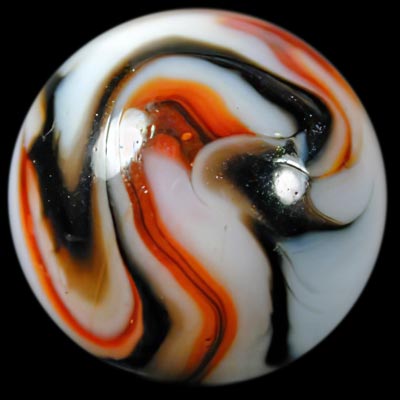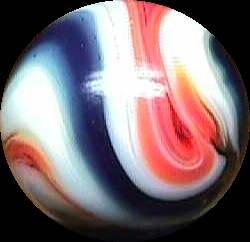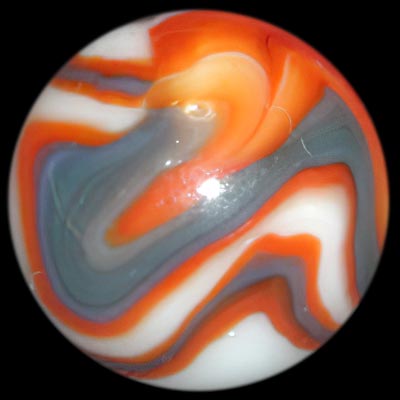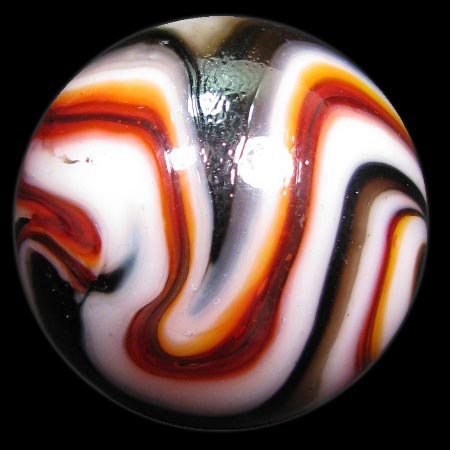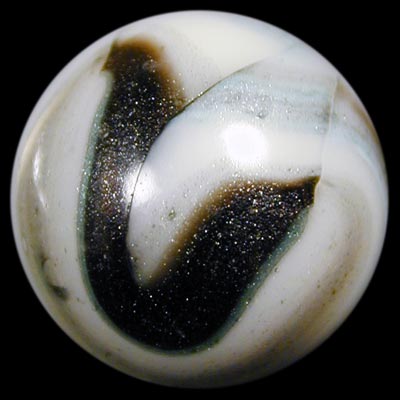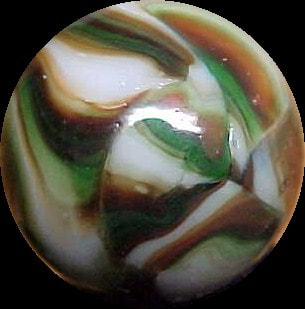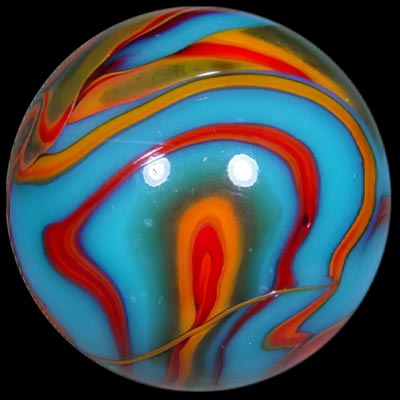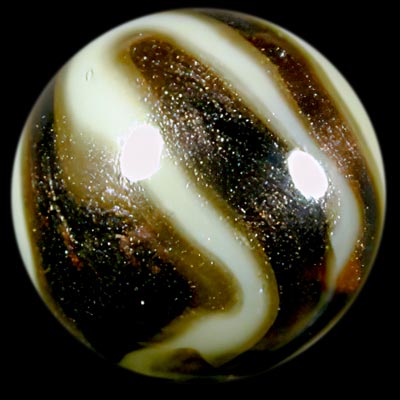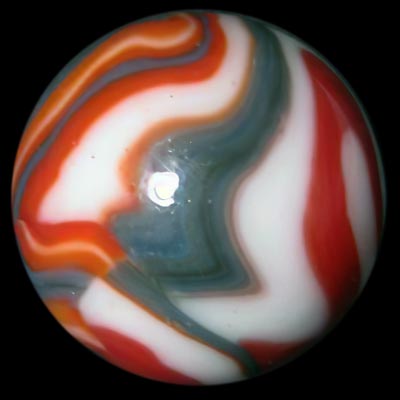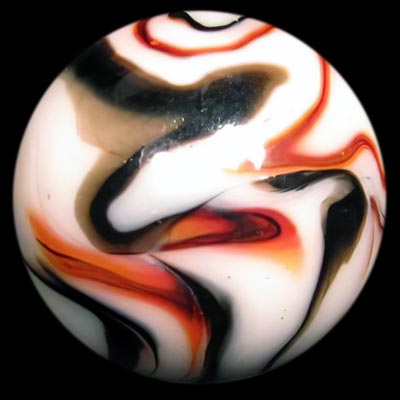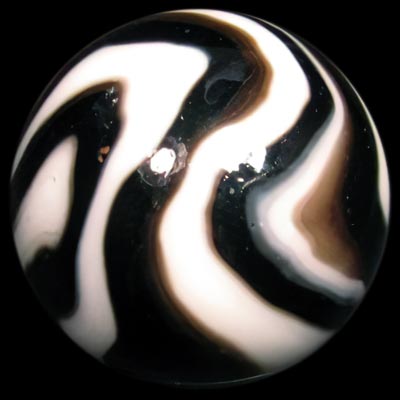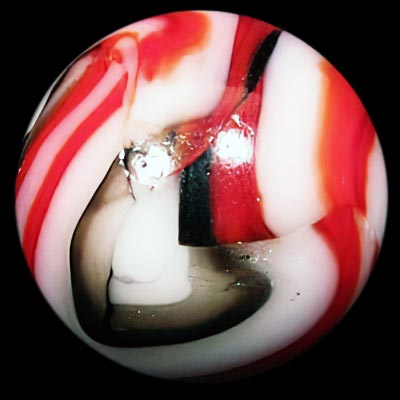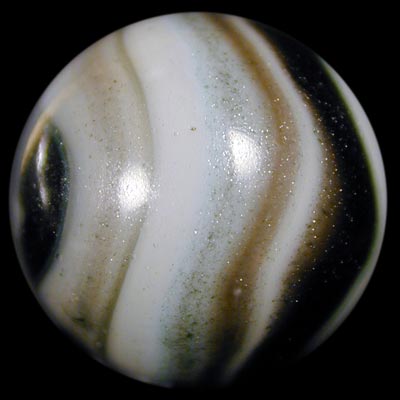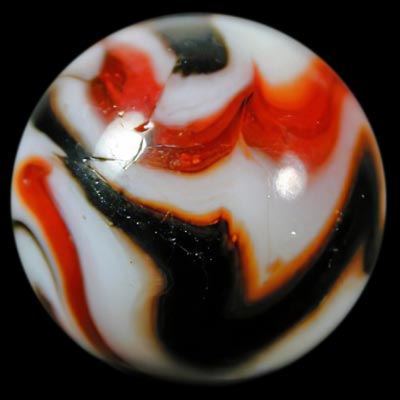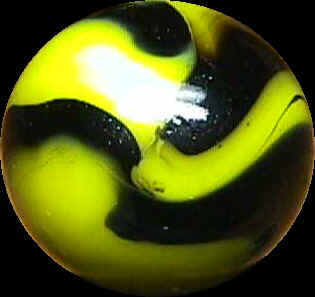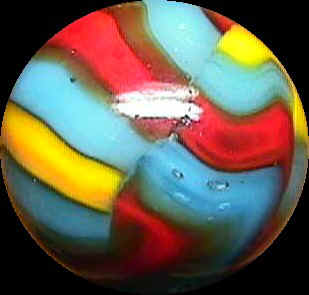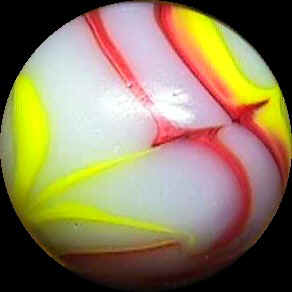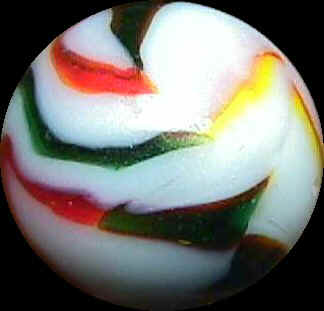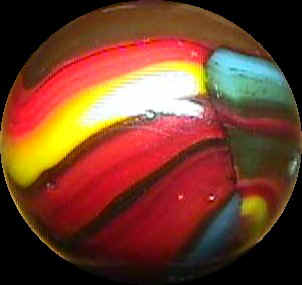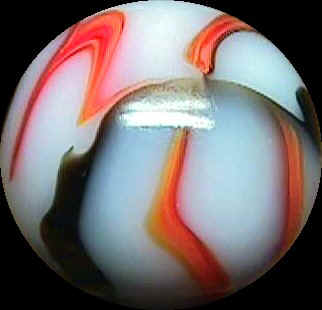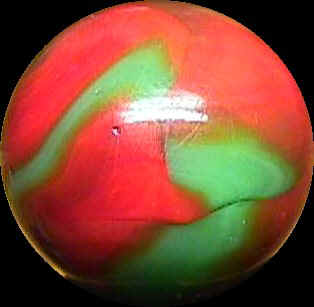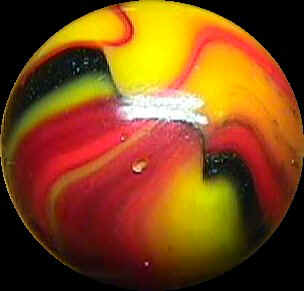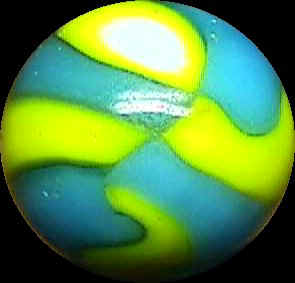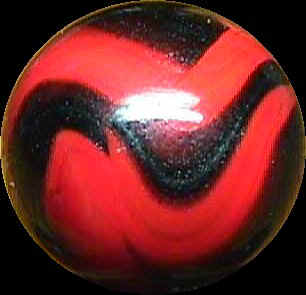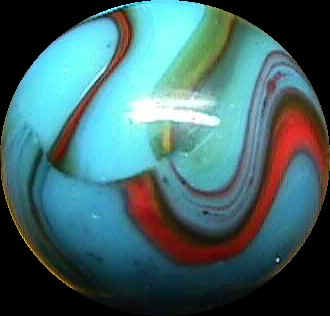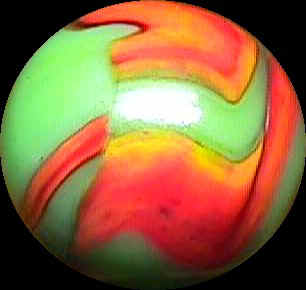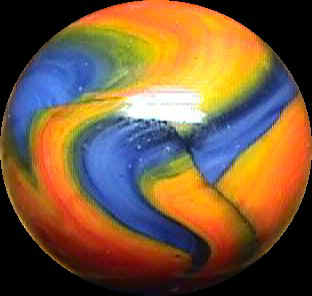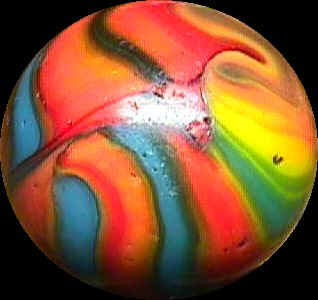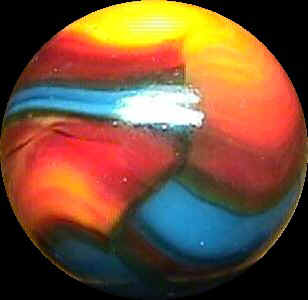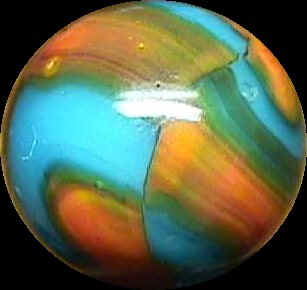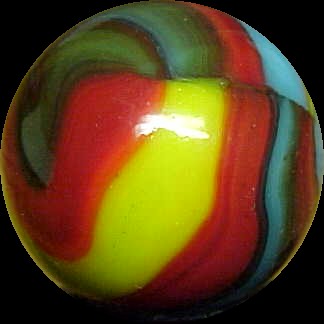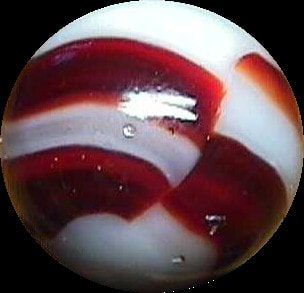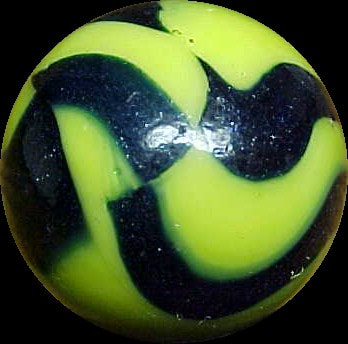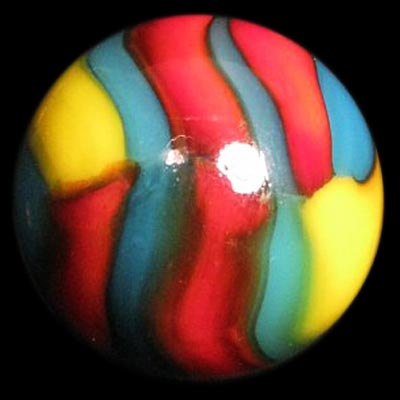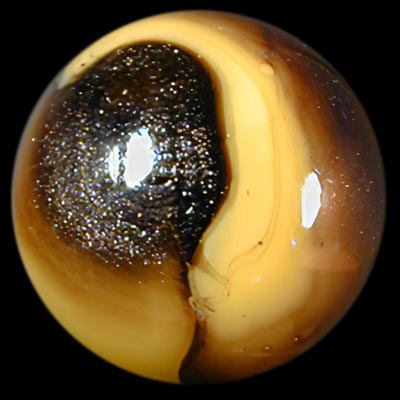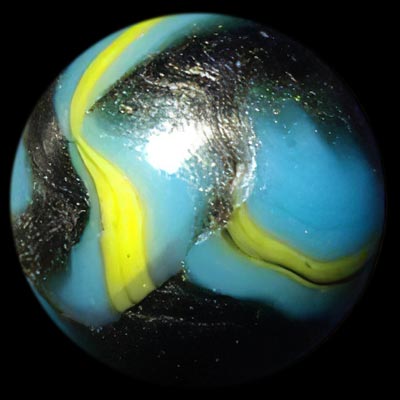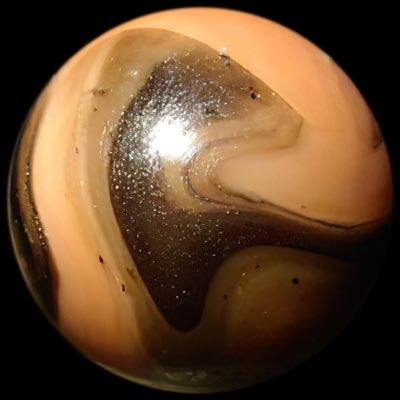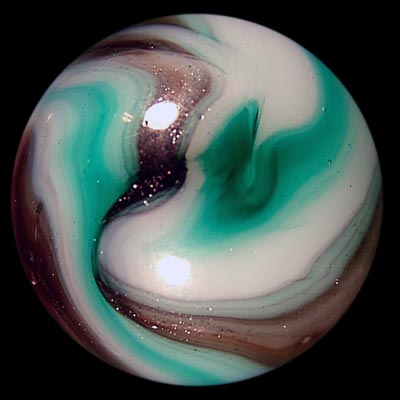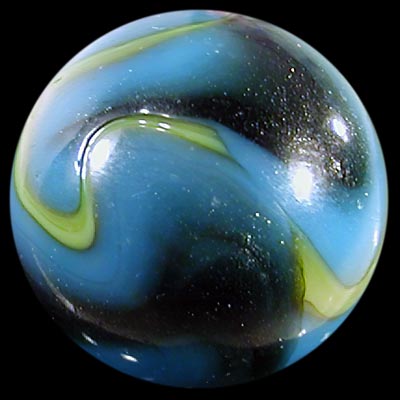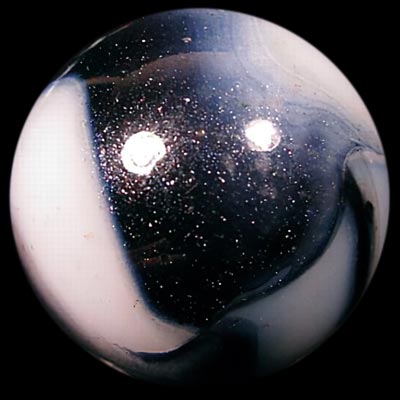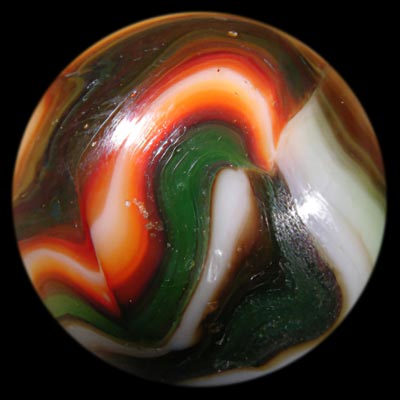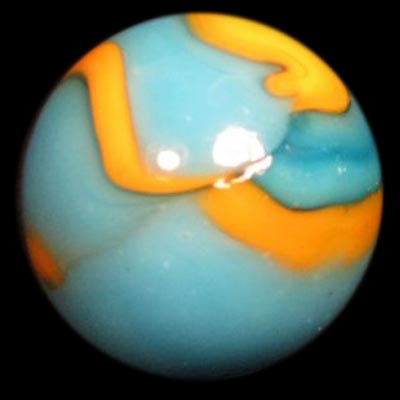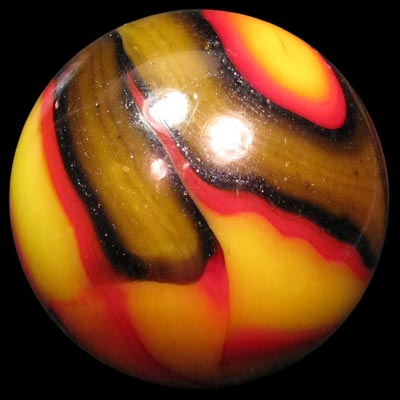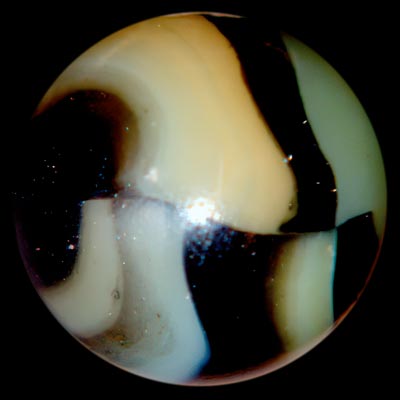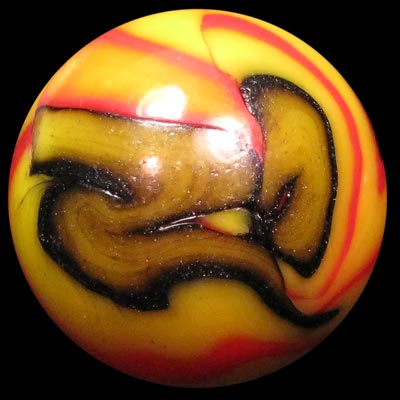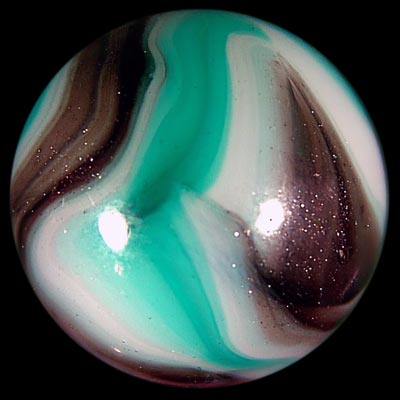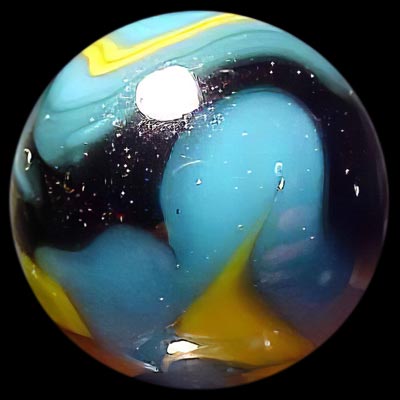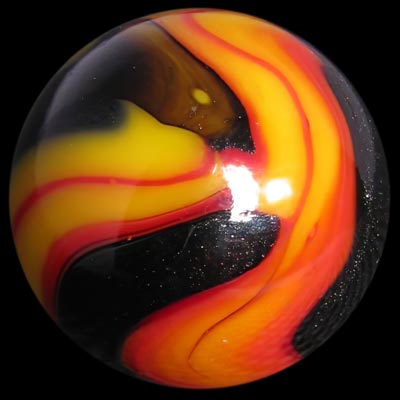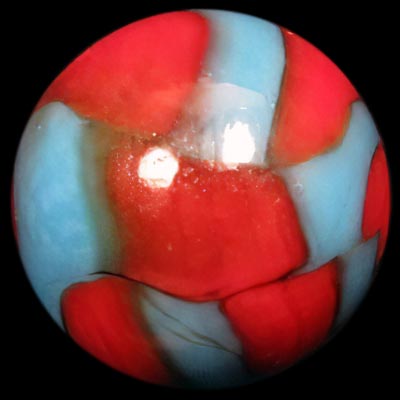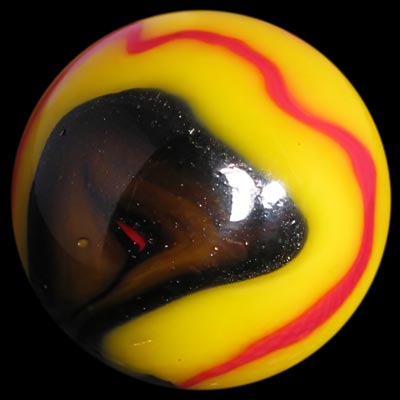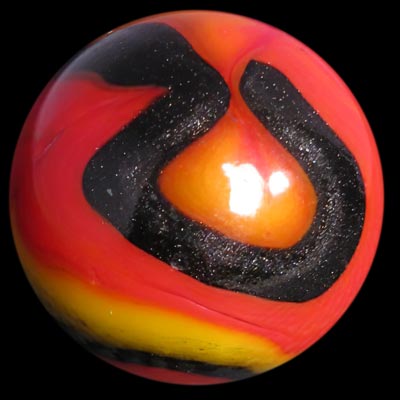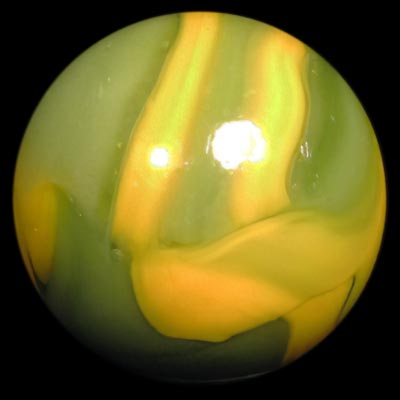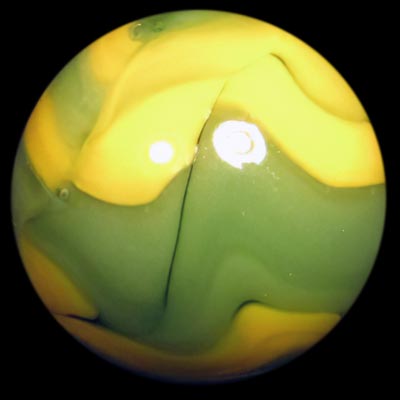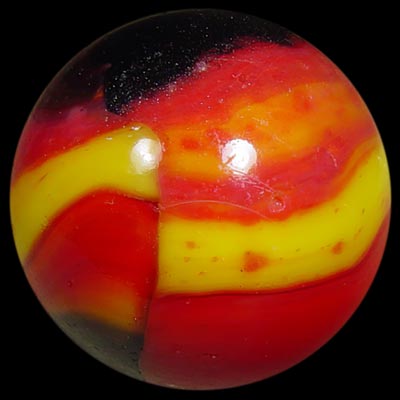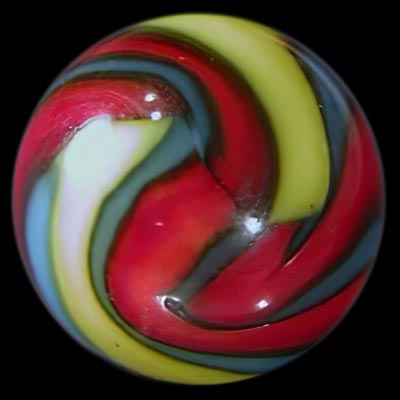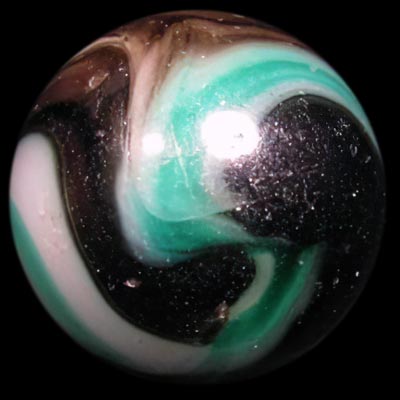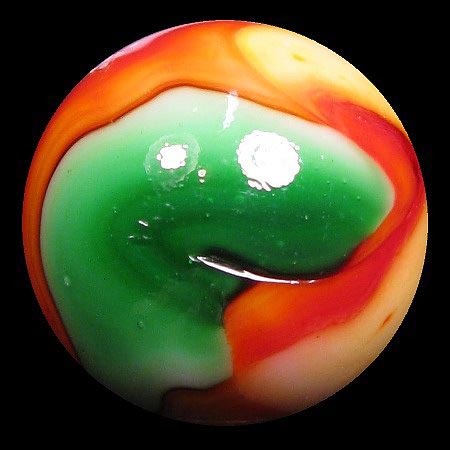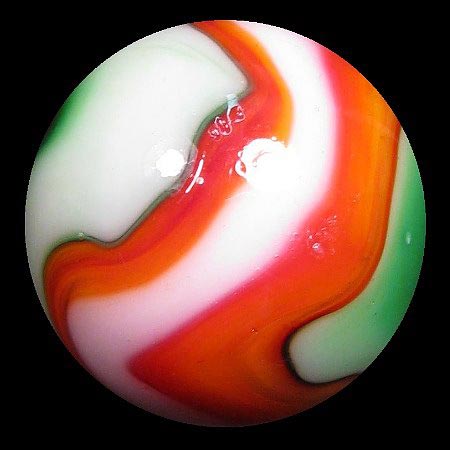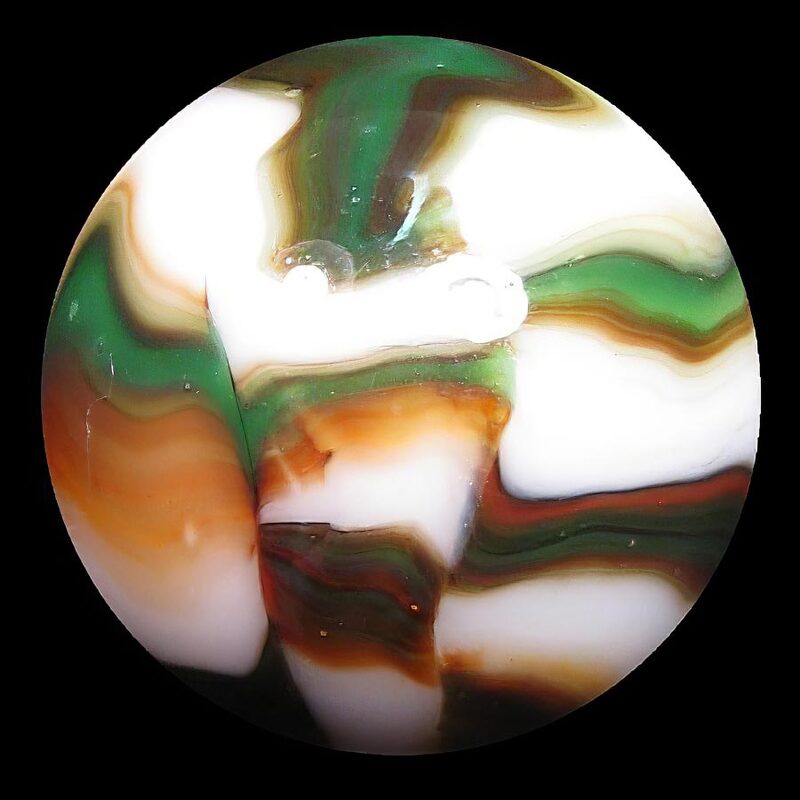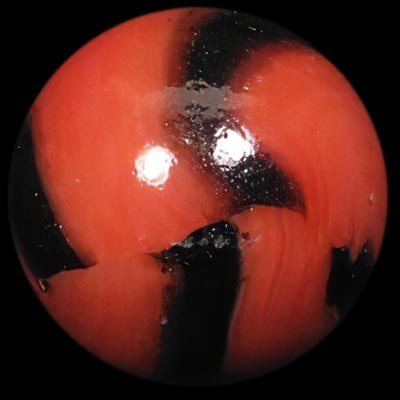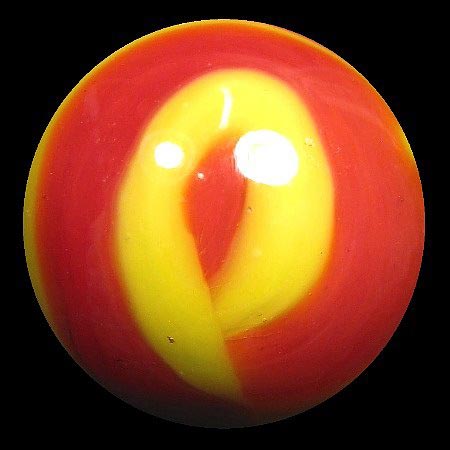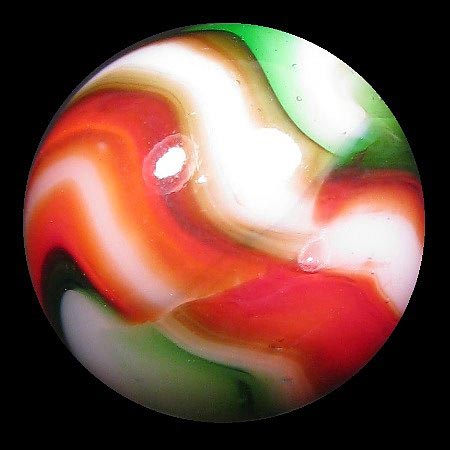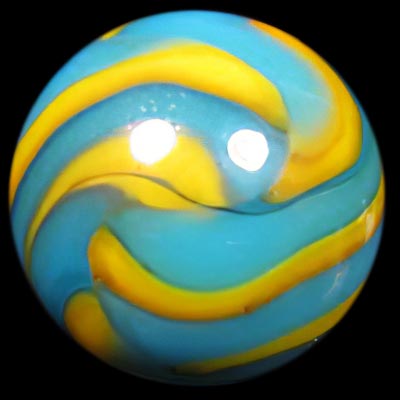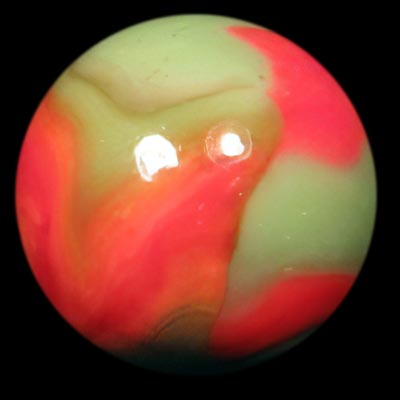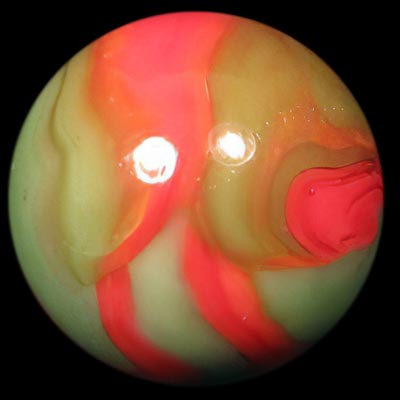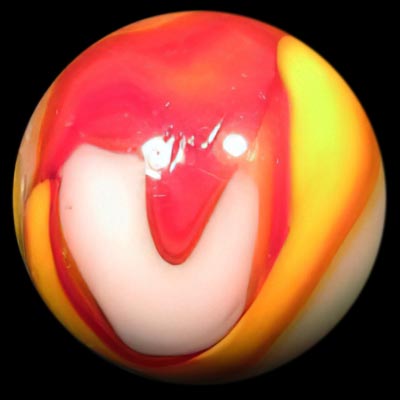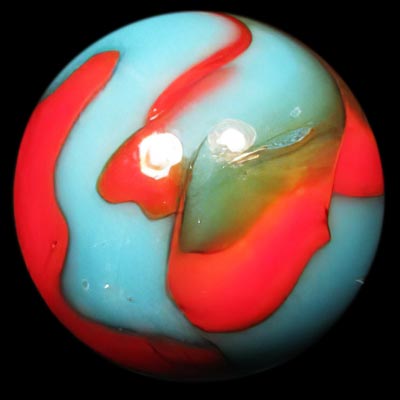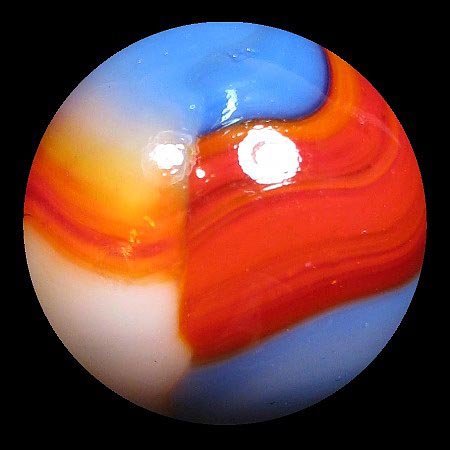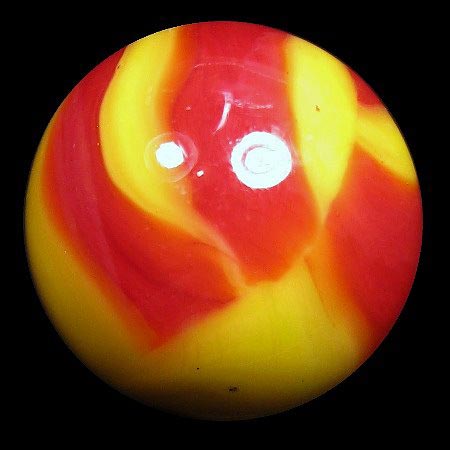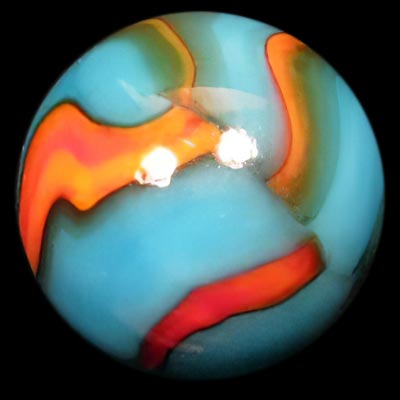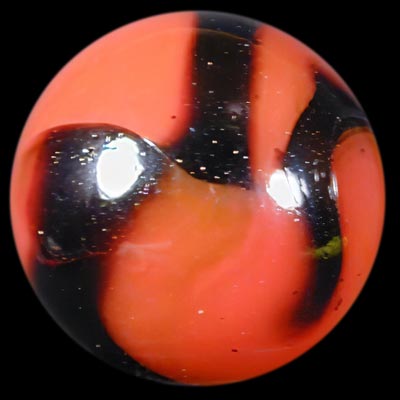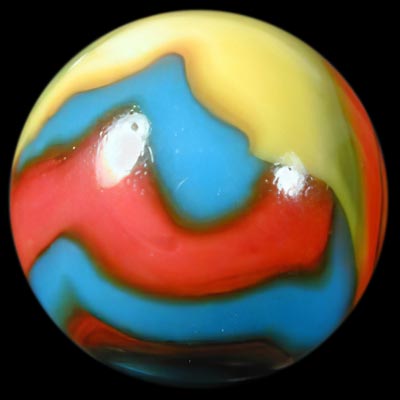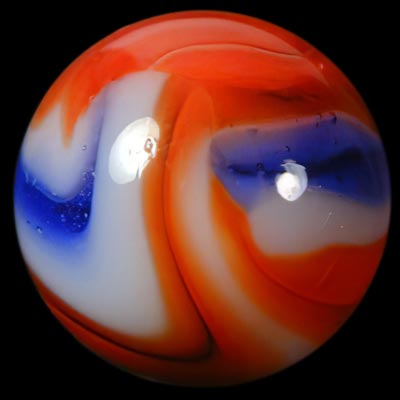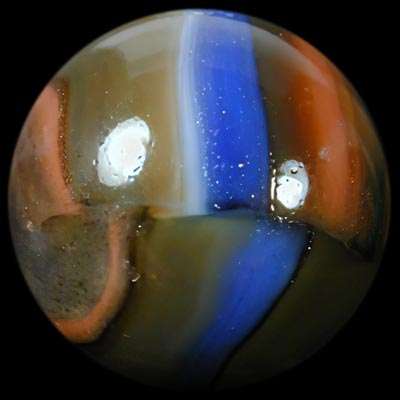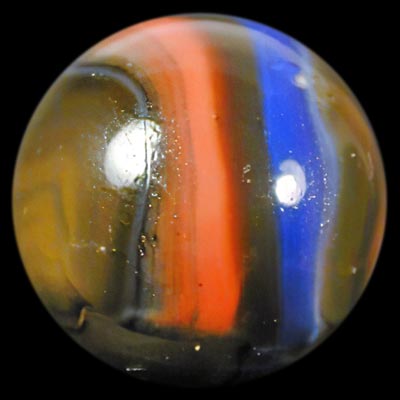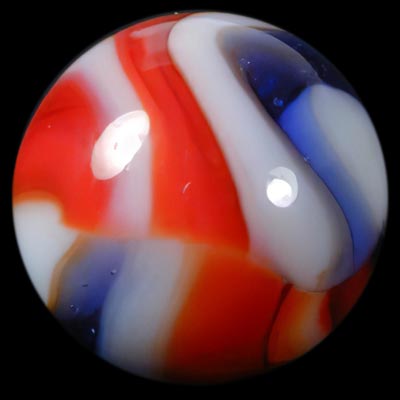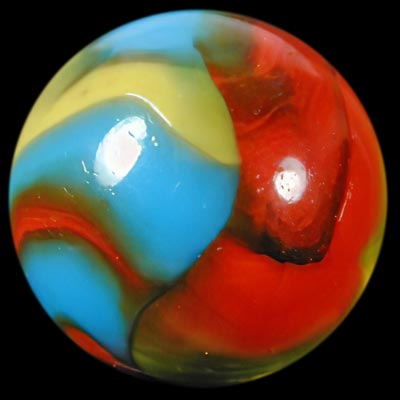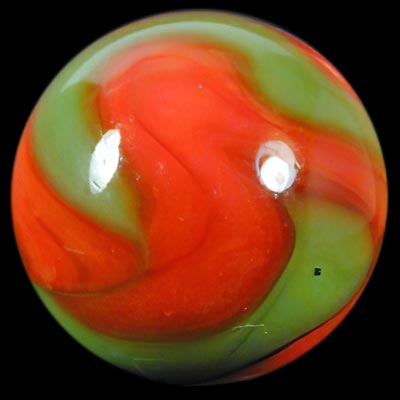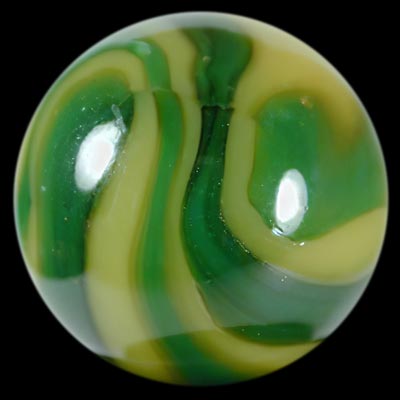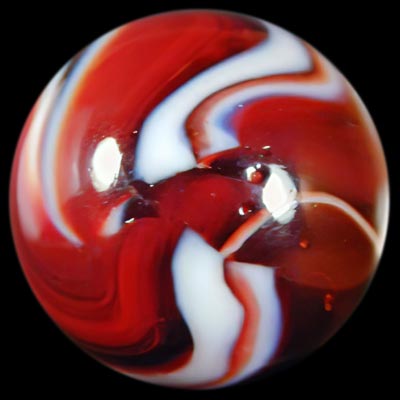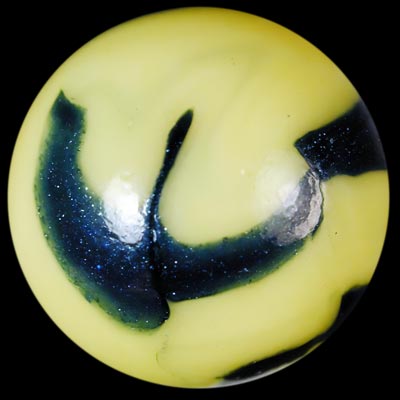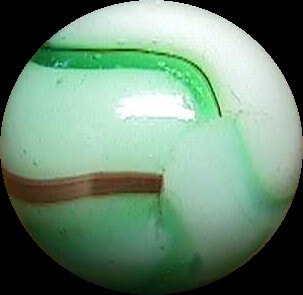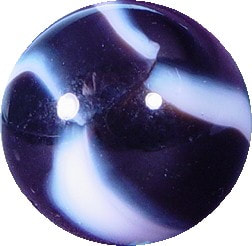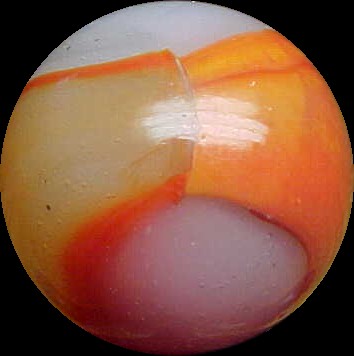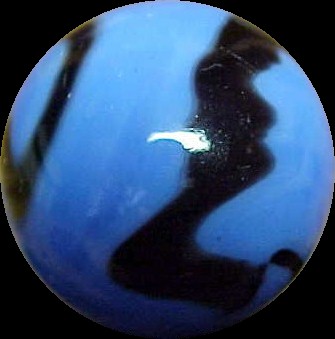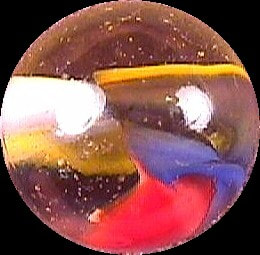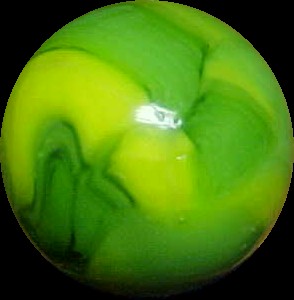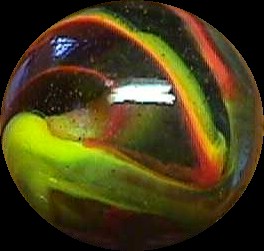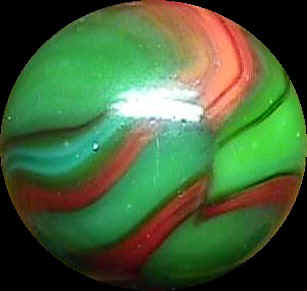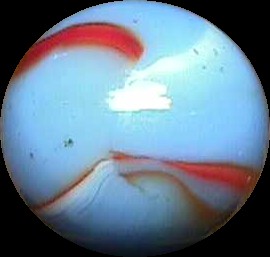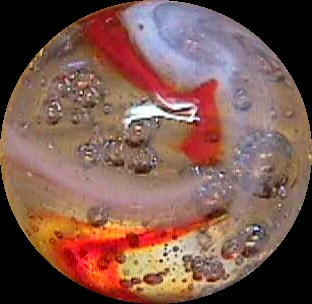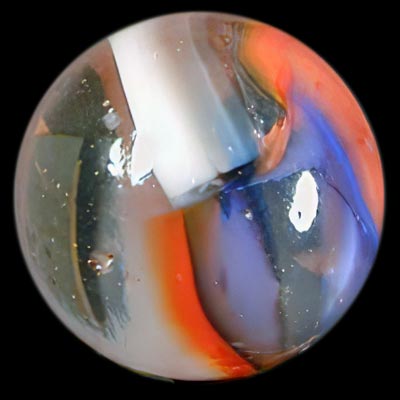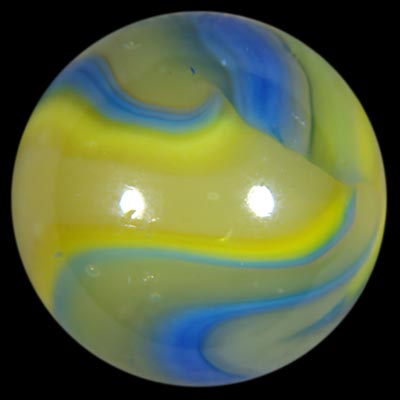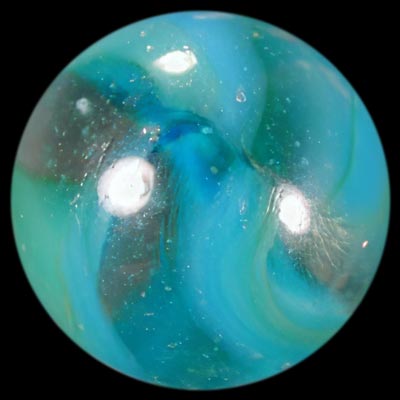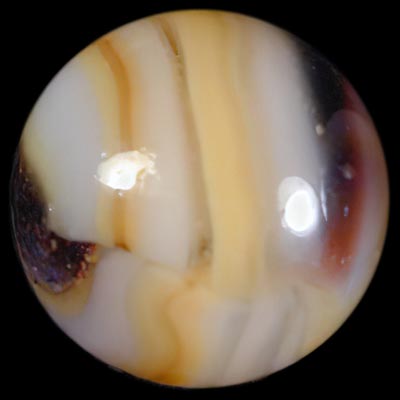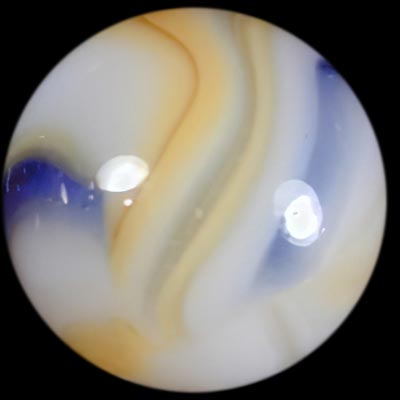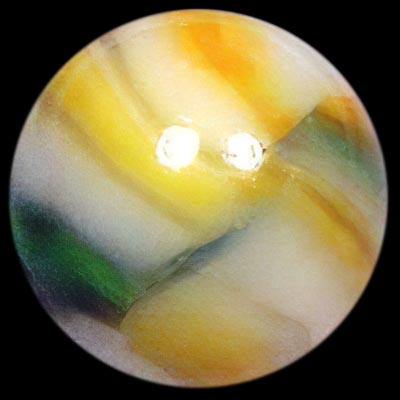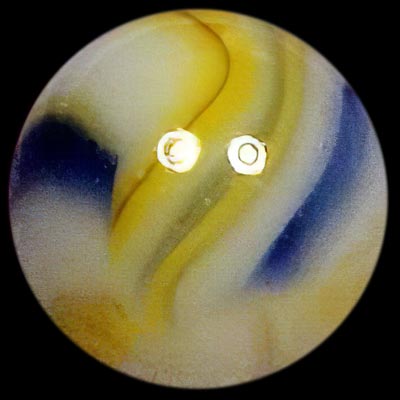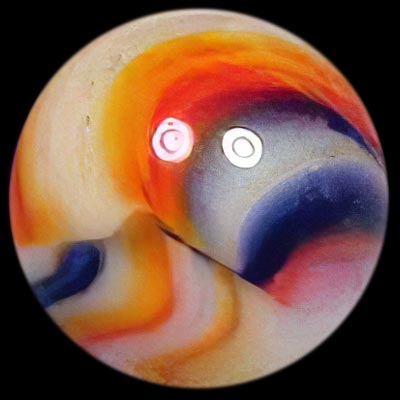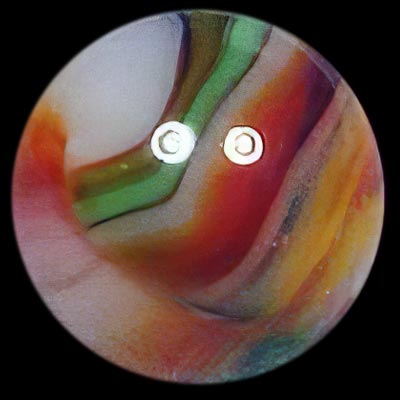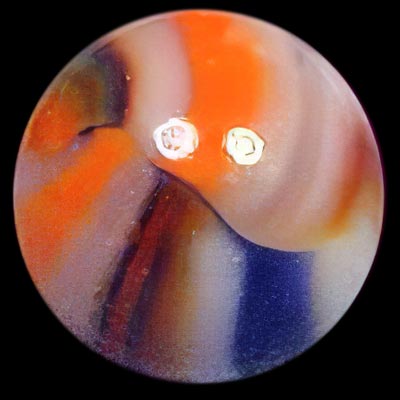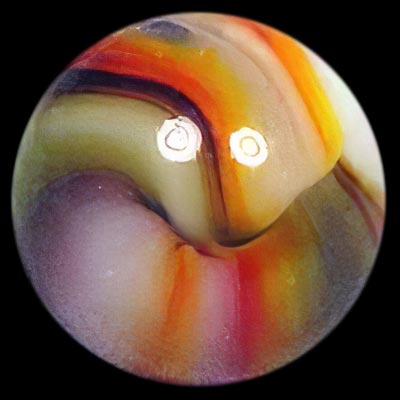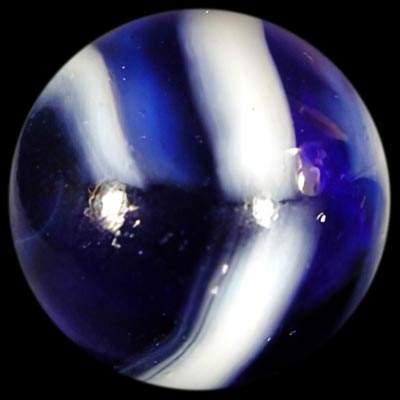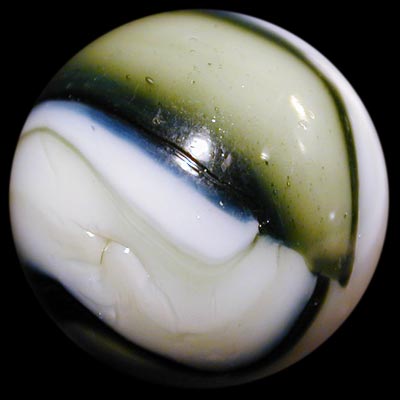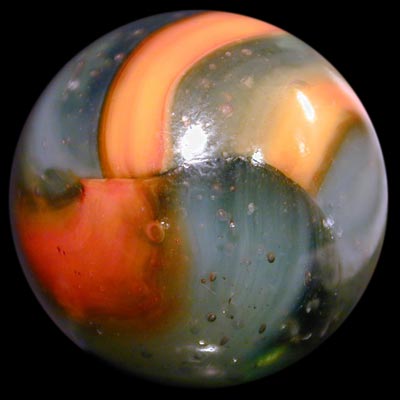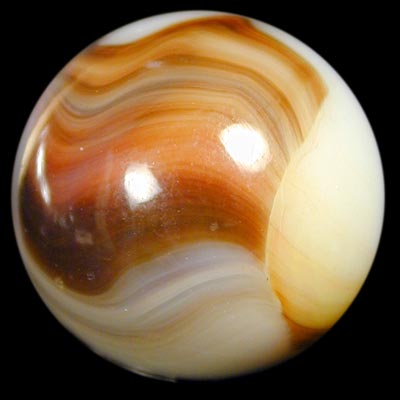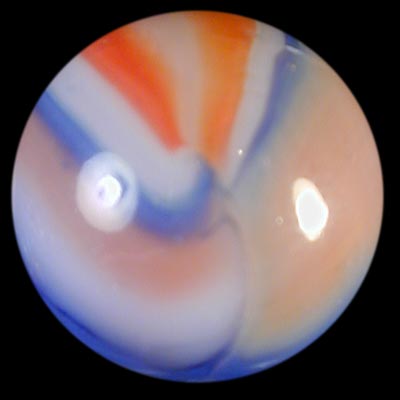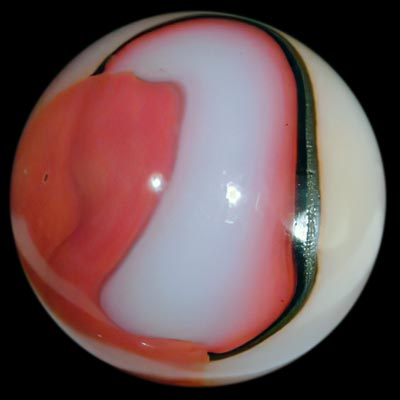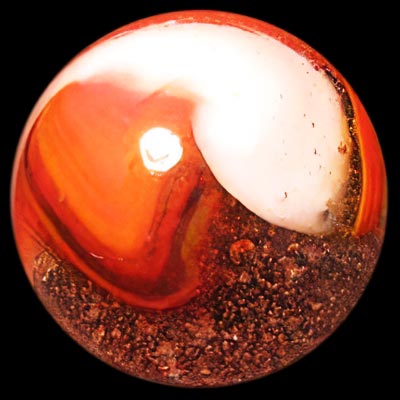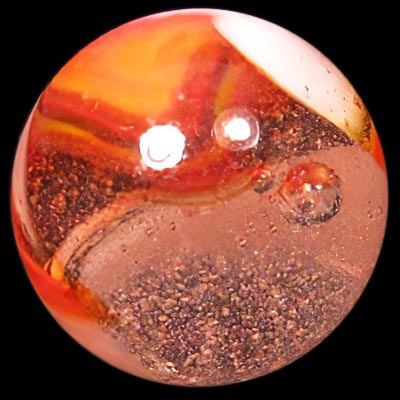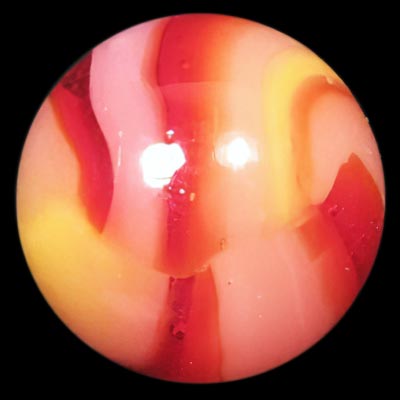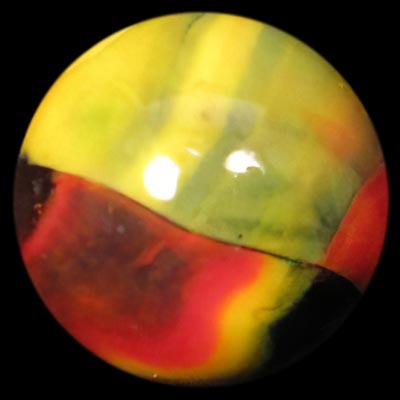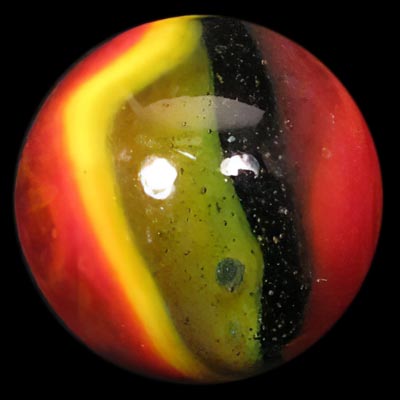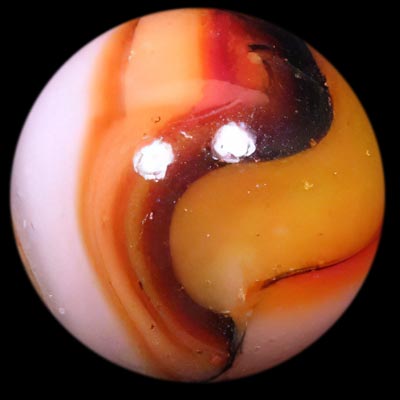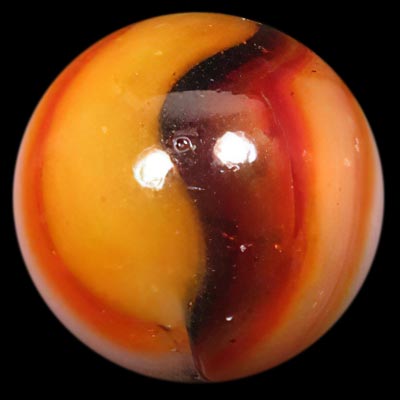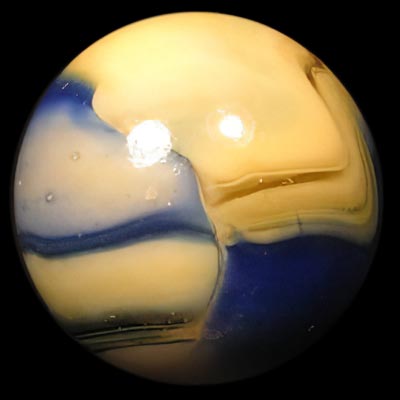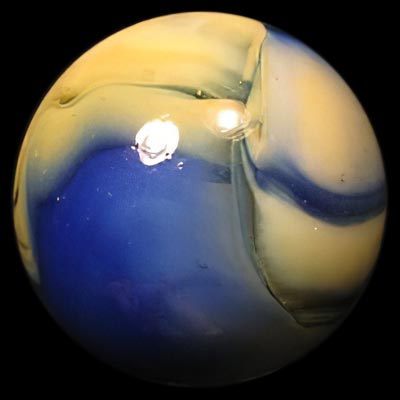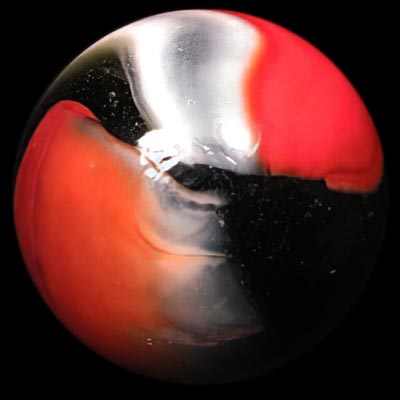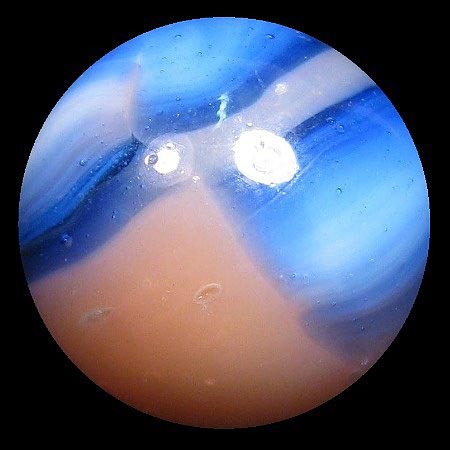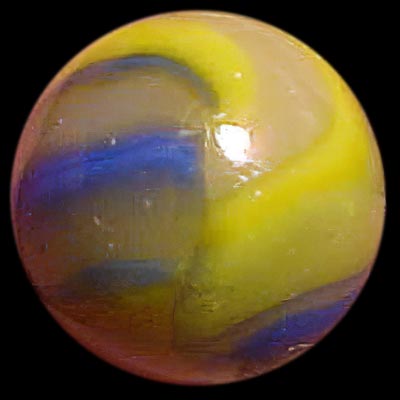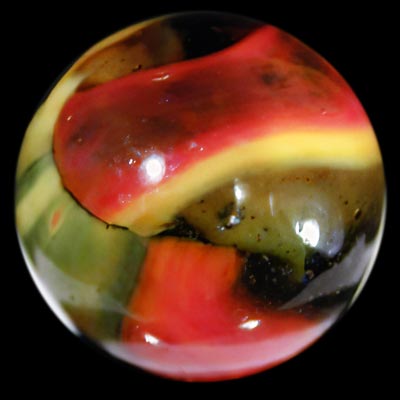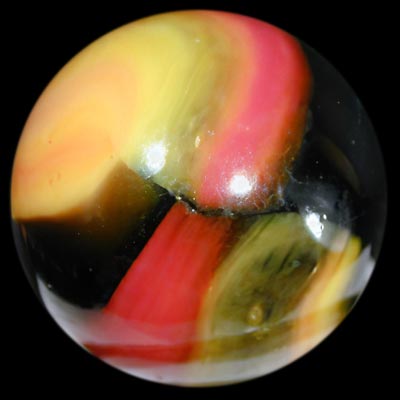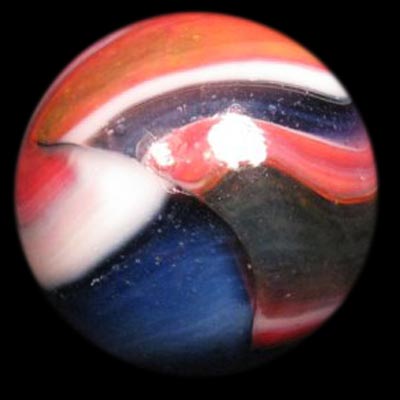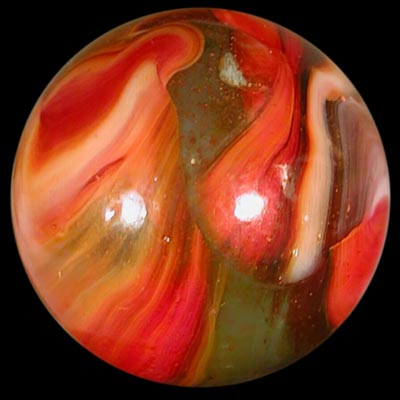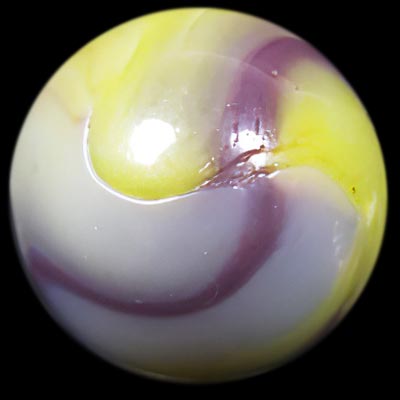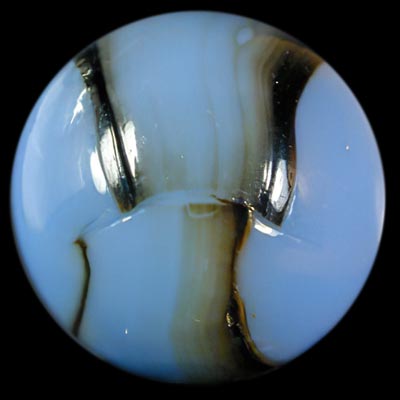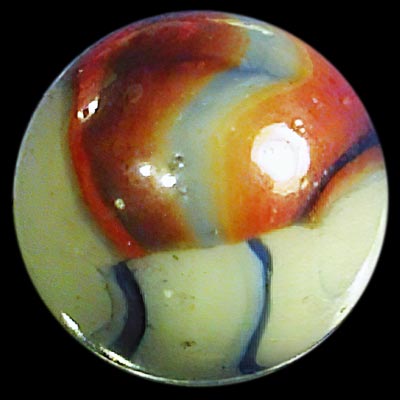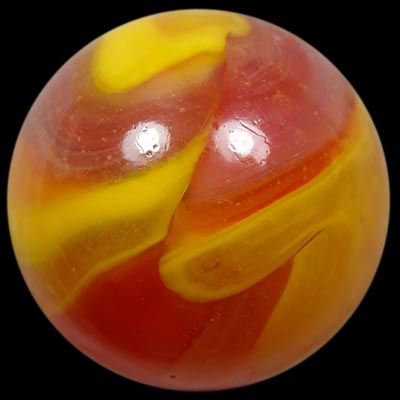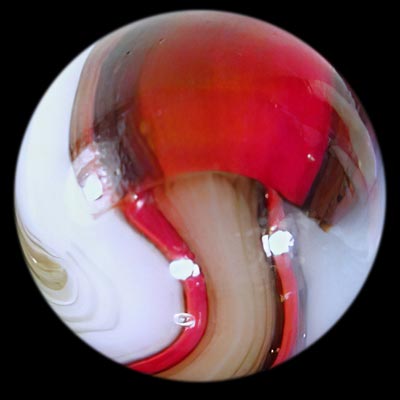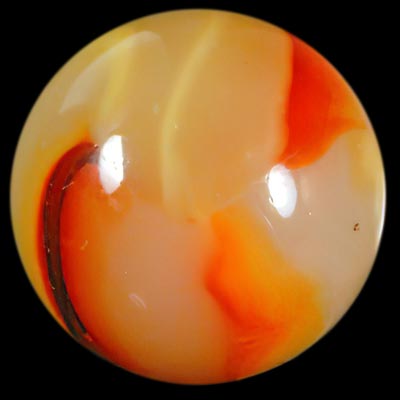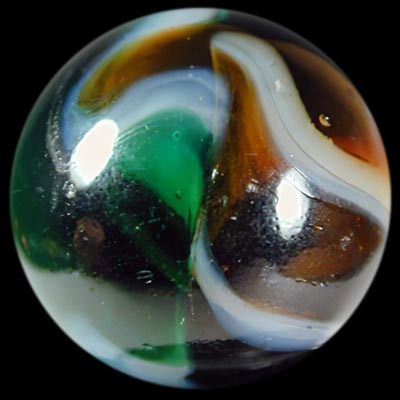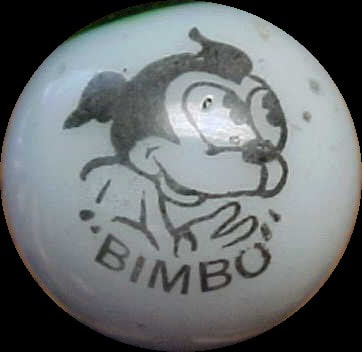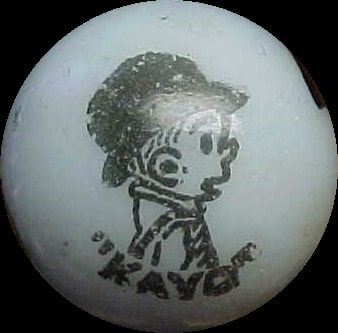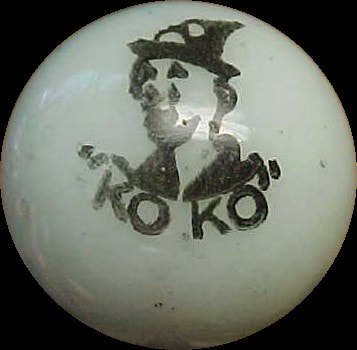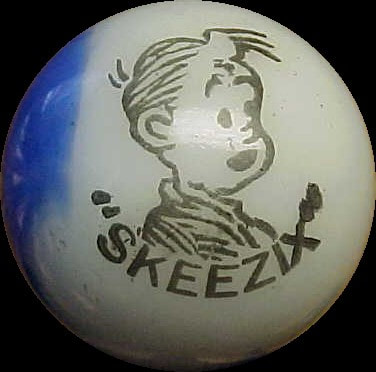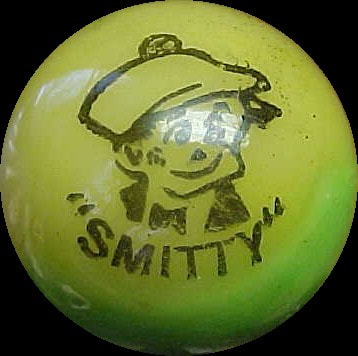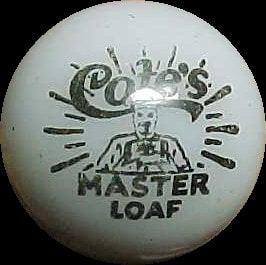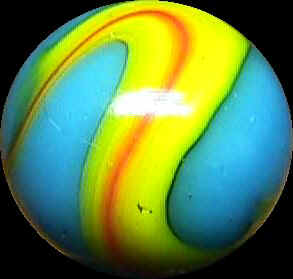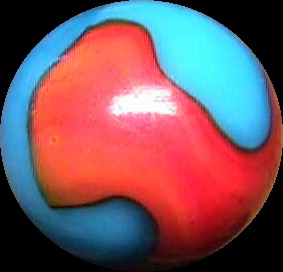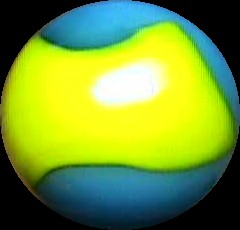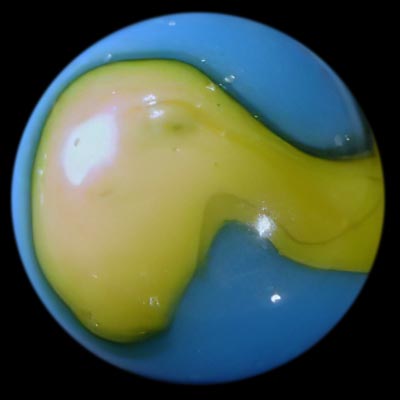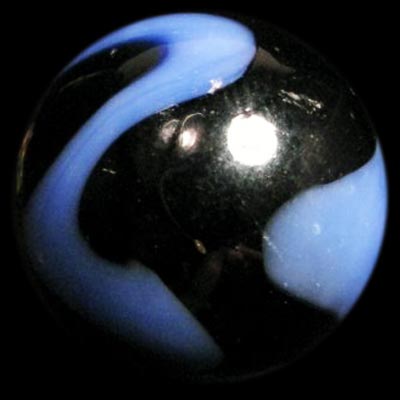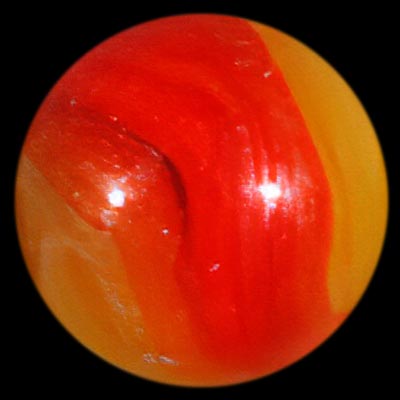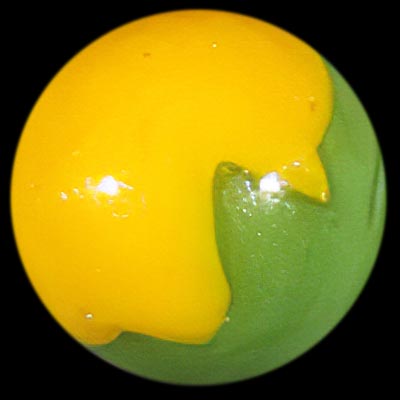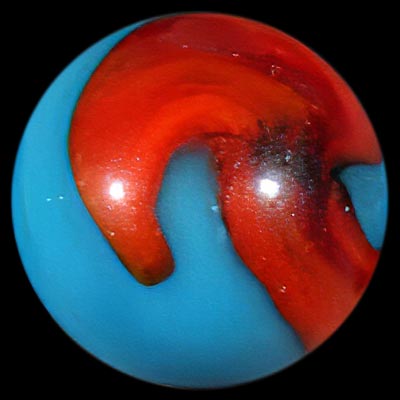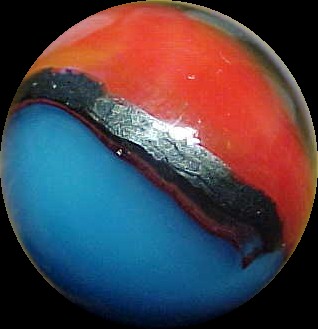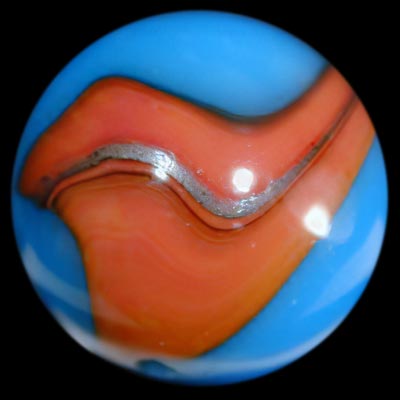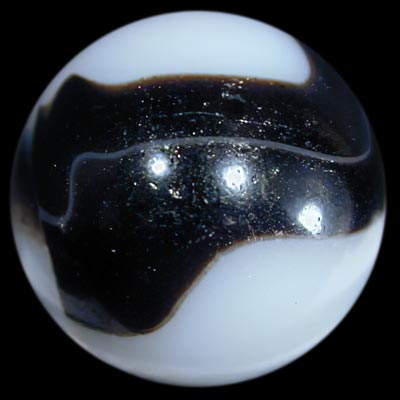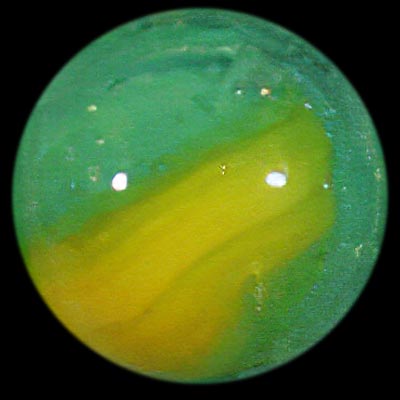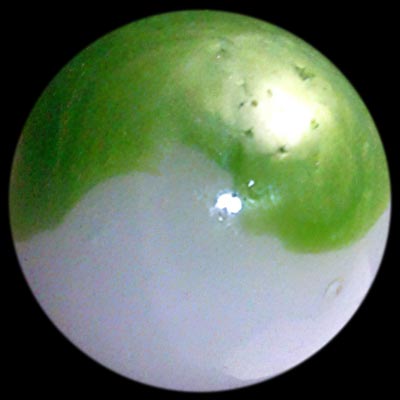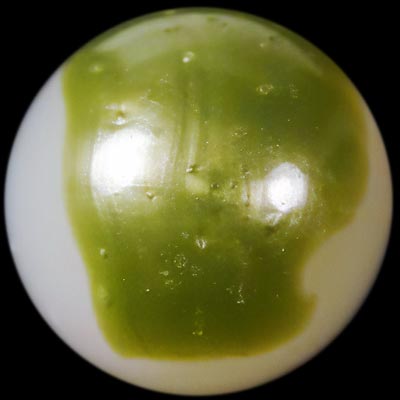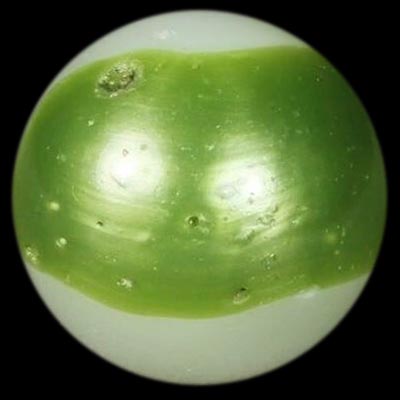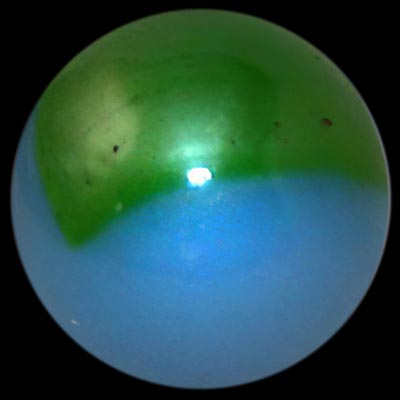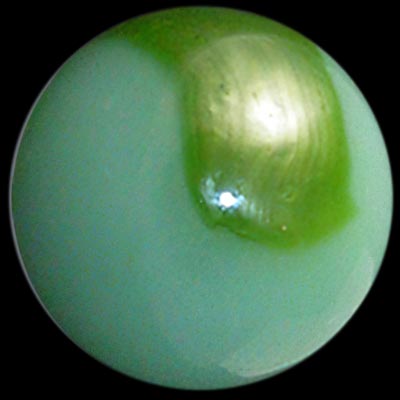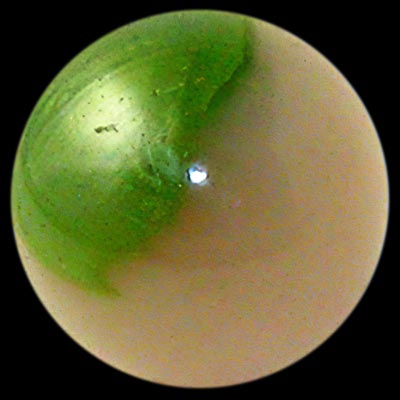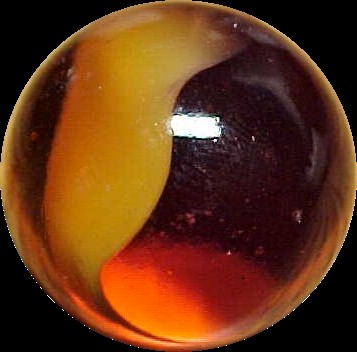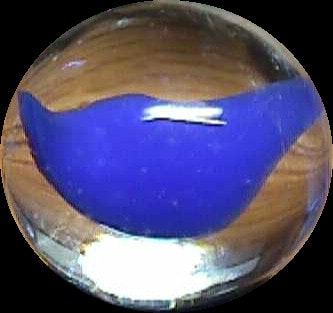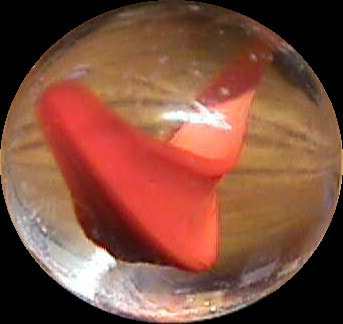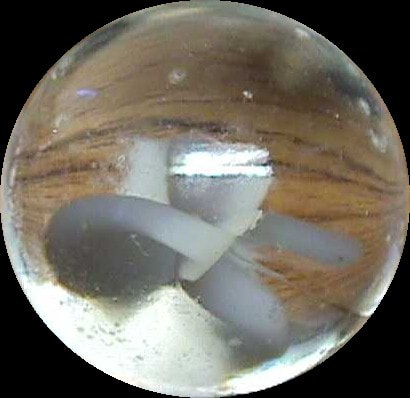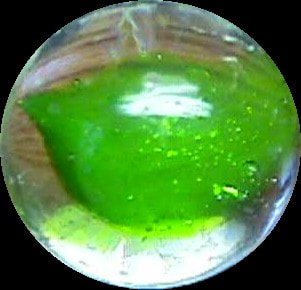PELTIER GLASS COmpany (1886-2002)
COMPANY HISTORY
The Peltier Glass Company, located in Ottawa, Illinois, has its roots in the 1880s but did not begin producing marbles until the 1920s. However, when it did begin manufacturing them the company did it with a flourish.
The story of Peltier Glass begins in 1859 when Victor Peltier, a glass craftsman, immigrated to the United States from his native France. He moved to Ottawa, Illinois, and worked at the Ottawa Flint Glass and Bottle Company from 1882 to 1886. At this time he established the Novelty Glass Company in Ottawa. This location was already home to several other glass companies, owing to the allure of its deposits of silica, which were among the purest in the nation. Here, Peltier manufactured a variety of glass items, including lamp chimneys, library lamp shades, Pullman car windows, cathedral windows, and more. Most of these items were composed of opalescent glass.
In 1919 the factory burned down. Peltier rebuilt it and changed the name to the Peltier Glass Company. Shortly thereafter, Victor's two sons, Sellers and Joseph, took over the company, along with one of their own sons. Soon, the Peltier brothers included marble manufacturing among their company's operations. This began around 1927, and the machinery used was patented by William J. Miller in 1926. This machinery was actually made in 1920 and used by Nivison-Weiskopf Company until 1924, when it was probably sold to Peltier. Records indicate that this little known company produced some 2,700,000 marbles with Miller's machine, though it is currently unknown what these marbles looked like.
In their first full year of marble manufacture, Peltier produced approximately 33,000,000 marbles. The earliest Peltier marbles were made with the single-stream Miller machinery. Swirls and slags were produced in this manner. Within a few years Peltier updated the machinery, which eliminated the random swirling if "Miller" marbles. Due to declining sales in later decades, mostly due to the influx of the extremely popular "catseyes" from Japan, Peltier stopped producing marbles in 2002.
The Peltier Glass Company, located in Ottawa, Illinois, has its roots in the 1880s but did not begin producing marbles until the 1920s. However, when it did begin manufacturing them the company did it with a flourish.
The story of Peltier Glass begins in 1859 when Victor Peltier, a glass craftsman, immigrated to the United States from his native France. He moved to Ottawa, Illinois, and worked at the Ottawa Flint Glass and Bottle Company from 1882 to 1886. At this time he established the Novelty Glass Company in Ottawa. This location was already home to several other glass companies, owing to the allure of its deposits of silica, which were among the purest in the nation. Here, Peltier manufactured a variety of glass items, including lamp chimneys, library lamp shades, Pullman car windows, cathedral windows, and more. Most of these items were composed of opalescent glass.
In 1919 the factory burned down. Peltier rebuilt it and changed the name to the Peltier Glass Company. Shortly thereafter, Victor's two sons, Sellers and Joseph, took over the company, along with one of their own sons. Soon, the Peltier brothers included marble manufacturing among their company's operations. This began around 1927, and the machinery used was patented by William J. Miller in 1926. This machinery was actually made in 1920 and used by Nivison-Weiskopf Company until 1924, when it was probably sold to Peltier. Records indicate that this little known company produced some 2,700,000 marbles with Miller's machine, though it is currently unknown what these marbles looked like.
In their first full year of marble manufacture, Peltier produced approximately 33,000,000 marbles. The earliest Peltier marbles were made with the single-stream Miller machinery. Swirls and slags were produced in this manner. Within a few years Peltier updated the machinery, which eliminated the random swirling if "Miller" marbles. Due to declining sales in later decades, mostly due to the influx of the extremely popular "catseyes" from Japan, Peltier stopped producing marbles in 2002.
IDENTIFICATION TIPS
Like Akro Agate and Christensen, early Peltier marbles are often composed of brilliant combinations of color. The first marbles by Peltier were produced by Miller machinery, and were single-stream slags and swirls. many Peltier marbles, especially early examples, have as-made blow-out holes that appear on the surface of the marble as tiny pits. Peltier marble sizes seem to be more variable than those of most other companies, and they produced many peewee marbles, in diminutive sizes for the most part not seen from other major manufacturers. However, some of their marbles, such as the National Line Rainbos (see below), are extremely rare in peewee (under 1/2") or shooter (over 3/4") sizes.
SLAGS
Peltier slags were called National Onyx by the company and were available in colors of brown, blue, green, aqua, purple, red, and yellow, in approximate increasing order of rarity. Early Peltier slags lack seams while later ones often have them. Regardless of when they were made, most Peltier slags exhibit a fine feathering of the white glass, a trait not seen in slags manufactured by other companies. More than anything, this is the key to identifying them.
Like Akro Agate and Christensen, early Peltier marbles are often composed of brilliant combinations of color. The first marbles by Peltier were produced by Miller machinery, and were single-stream slags and swirls. many Peltier marbles, especially early examples, have as-made blow-out holes that appear on the surface of the marble as tiny pits. Peltier marble sizes seem to be more variable than those of most other companies, and they produced many peewee marbles, in diminutive sizes for the most part not seen from other major manufacturers. However, some of their marbles, such as the National Line Rainbos (see below), are extremely rare in peewee (under 1/2") or shooter (over 3/4") sizes.
SLAGS
Peltier slags were called National Onyx by the company and were available in colors of brown, blue, green, aqua, purple, red, and yellow, in approximate increasing order of rarity. Early Peltier slags lack seams while later ones often have them. Regardless of when they were made, most Peltier slags exhibit a fine feathering of the white glass, a trait not seen in slags manufactured by other companies. More than anything, this is the key to identifying them.
PELTIER SLAGS GALLERY
(Hover your mouse or lightly touch the image to see the type of marble. Click to view the full size image)
(Hover your mouse or lightly touch the image to see the type of marble. Click to view the full size image)
MILLER SWIRLS
As mentioned, the earliest Peltier marbles (late 1920s) were produced by machinery patented by William Miller. As single-stream machines, Miller swirls are characterized by random swirling, though they typically will have a single seam from which the swirls originate. Most Miller swirls are composed of bright colors, which are often in the same combinations as the National Line Rainbos (discussed below).
Multicolored Swirls are a type of Miller swirl that have a transparent base, usually green, with swirls of several different colors. This type lacks seams. A specialized variety is known as the Honey Onyx; this marble will have a semi-opaque white base with a translucent yellowish brown patch and a thin translucent green ribbon.
As mentioned, the earliest Peltier marbles (late 1920s) were produced by machinery patented by William Miller. As single-stream machines, Miller swirls are characterized by random swirling, though they typically will have a single seam from which the swirls originate. Most Miller swirls are composed of bright colors, which are often in the same combinations as the National Line Rainbos (discussed below).
Multicolored Swirls are a type of Miller swirl that have a transparent base, usually green, with swirls of several different colors. This type lacks seams. A specialized variety is known as the Honey Onyx; this marble will have a semi-opaque white base with a translucent yellowish brown patch and a thin translucent green ribbon.
MILLER SWIRLS GALLERY
(Hover your mouse or lightly touch the image to see the type of marble. Click to view the full size image)
(Hover your mouse or lightly touch the image to see the type of marble. Click to view the full size image)
NATIONAL LINE RAINBOS
Among Peltier's most popular marbles are the National Line Rainbos (sometimes referred to as NLRs) which were produced as early as the late 1920s and up to the late 1930s. All National Line Rainbos will exhibit two seams, which differentiates them from the earlier Miller swirls. Most have an opaque base, though some are semi-opaque or translucent. The design will consist of "ribbons" of opaque to transparent color. There will be one or more colors represented on the ribbons, and usually there will be four or six ribbons present. Rarely, the ribbons will have aventurine glass in them, usually in black ribbons but also present on extremely rare occasions in blue or red ribbons. Aventurine is a type of glass with finely ground particles of copper (golden), chromic oxide (green), or ferric oxide (red), silver and blue which causes it to sparkle under illumination, especially direct sunlight.
Collectors have assigned a variety of names to National Line Rainbos to describe their different combinations of color. A Superman will have a light blue base with yellow and red ribbons. Golden Rebels have a yellow base with red and black ribbons (there is often aventurine in the black). A Ketchup and Mustard has a white base with red and yellow ribbons. Christmas Trees also have a white base, but on these the ribbons are green and red. A Liberty has a white base, with blue and red ribbons, and a Rebel has a white base with black and red ribbons. Again, there is often aventurine in the black ribbons of the latter type. Other varieties include the Bumblebee (yellow with black ribbons), Zebra (white with black ribbons), Blue Bee (yellow with blue aventurine ribbons) Lemon Lime (lime green with yellow ribbons), Bloodie (transparent red on translucent off-white), Blue Zebra (white with blue ribbons), Red Zebra (white with red ribbons which often have aventurine), Cub Scout (blue with yellow ribbons), Wasp (red with black ribbons), Blue Wasp (red with blue ribbons), Tiger (orange with black ribbons), Blue Tiger (orange with blue ribbons), Spiderman (light blue with red ribbons), Superboy (light blue with blended red and yellow ribbons---usually the red lies on top of the yellow), Burnt Christmas Tree (white with green and reddish brown ribbons), Dragon (light green with red ribbons), Flaming Dragon (light green with red and yellow ribbons---usually the colors are blended to create a more orange effect), Blue Galaxy (light blue with aventurine black and yellow ribbons), Black Panda (black with white ribbons), Chocolate Cow (brown with black ribbons), Gray Coat (white with red and gray ribbons), and Submarine (translucent blue with wispy white base and orange ribbons). Sometimes the colors are blended, and often these marbles are very beautiful due to the multicolored effect. It should be noted that other, unnamed, color combinations are known, and also there are hybrids with three or more different colored ribbons. These latter examples are extremely rare. Also very scarce are National Line Rainbos with oxblood. New names for Peltier marbles are constantly being invented by collectors, and it can be difficult to keep up with.
Recently, there has been an effort to further define National Line Rainbos based on their style of ribboning as follows:
Among Peltier's most popular marbles are the National Line Rainbos (sometimes referred to as NLRs) which were produced as early as the late 1920s and up to the late 1930s. All National Line Rainbos will exhibit two seams, which differentiates them from the earlier Miller swirls. Most have an opaque base, though some are semi-opaque or translucent. The design will consist of "ribbons" of opaque to transparent color. There will be one or more colors represented on the ribbons, and usually there will be four or six ribbons present. Rarely, the ribbons will have aventurine glass in them, usually in black ribbons but also present on extremely rare occasions in blue or red ribbons. Aventurine is a type of glass with finely ground particles of copper (golden), chromic oxide (green), or ferric oxide (red), silver and blue which causes it to sparkle under illumination, especially direct sunlight.
Collectors have assigned a variety of names to National Line Rainbos to describe their different combinations of color. A Superman will have a light blue base with yellow and red ribbons. Golden Rebels have a yellow base with red and black ribbons (there is often aventurine in the black). A Ketchup and Mustard has a white base with red and yellow ribbons. Christmas Trees also have a white base, but on these the ribbons are green and red. A Liberty has a white base, with blue and red ribbons, and a Rebel has a white base with black and red ribbons. Again, there is often aventurine in the black ribbons of the latter type. Other varieties include the Bumblebee (yellow with black ribbons), Zebra (white with black ribbons), Blue Bee (yellow with blue aventurine ribbons) Lemon Lime (lime green with yellow ribbons), Bloodie (transparent red on translucent off-white), Blue Zebra (white with blue ribbons), Red Zebra (white with red ribbons which often have aventurine), Cub Scout (blue with yellow ribbons), Wasp (red with black ribbons), Blue Wasp (red with blue ribbons), Tiger (orange with black ribbons), Blue Tiger (orange with blue ribbons), Spiderman (light blue with red ribbons), Superboy (light blue with blended red and yellow ribbons---usually the red lies on top of the yellow), Burnt Christmas Tree (white with green and reddish brown ribbons), Dragon (light green with red ribbons), Flaming Dragon (light green with red and yellow ribbons---usually the colors are blended to create a more orange effect), Blue Galaxy (light blue with aventurine black and yellow ribbons), Black Panda (black with white ribbons), Chocolate Cow (brown with black ribbons), Gray Coat (white with red and gray ribbons), and Submarine (translucent blue with wispy white base and orange ribbons). Sometimes the colors are blended, and often these marbles are very beautiful due to the multicolored effect. It should be noted that other, unnamed, color combinations are known, and also there are hybrids with three or more different colored ribbons. These latter examples are extremely rare. Also very scarce are National Line Rainbos with oxblood. New names for Peltier marbles are constantly being invented by collectors, and it can be difficult to keep up with.
Recently, there has been an effort to further define National Line Rainbos based on their style of ribboning as follows:
- Type One National Line Rainbos will have four to six ribbons that are heavily swirled as they run from seam to seam.
- Type Two National Line Rainbos will have four to six ribbons that run very straight from one seam to the other.
- Type Three National Line Rainbos have four ribbons, two each of which emanate from seams set on opposite sides of the marble but perpendicular to one another ("t"-shaped).
- Type Four National Line Rainbos also have four ribbons which form a "broken corkscrew" pattern as they swirl from one end of the marble to the other.
- Type Five National Line Rainbos have four ribbons, two of which form patches on either pole of the marble and two of which form equatorial bands. These latter marbles are often mistaken for Marble King ("patch and ribbon") Rainbows.
NATIONAL LINE RAINBO GALLERY
(Hover your mouse or lightly touch the image to see the type of marble. Click to view the full size image)
(Hover your mouse or lightly touch the image to see the type of marble. Click to view the full size image)
RAINBOS
Peltier Rainbos, the descendants of the National Line Rainbos, appear to have been first manufactured in the late 1930s and throughout the following decade. Composed of less brilliant glass, they were probably a response to a declining marble market and a need to reduce production costs. Like their predecessors, these marbles have two seams. They may have a base glass that is either opaque or transparent, and usually one or two ribbons that encircle the marble, usually near the center. Unlike on the National Line Rainbos, the ribbons on Rainbos often go into the base glass, whereas on the former they lie on and perhaps just underneath the surface. When looked at from the poles, the ribbons on the marble can resemble a baseball.
As with the National Line Rainbos, several types have been defined by their ribbon patterning.
Type One Rainbos are heavily swirled.
Type Two Rainbos have six ribbons, four that form two bands on the equator and two forming patches at either pole.
Type Three Rainbos have four ribbons which form two bands around the equator.
Most Rainbos have an opaque base, which is usually white though color-based examples are fairly common. Some of these have the same color combinations as National Line Rainbos, though they are generally duller. If the base is opalescent, and the ribbons are red, the marble is called a Bloodie. Sunsets are those that have a transparent bubble-filled clear base with red, orange, or yellow and white ribbons. Champions Jrs. have a dark transparent base with white and yellow ribbons. Tri-Color Rainbos have a colored base, either transparent or opaque, with ribbons of two different colors. Finally, Clear Rainbos are transparent clear-based, and have four or more different colored ribbons. Slightly resembling Markle King's Four-Color St. Marys Catseyes, these most often have a blue/red/yellow/white or green/red/yellow/white color combination. Almost all Clear Rainbos have thin ribbons, with around 10% possessing thicker ones.
Additional imaginative names have been adopted by collectors for various Rainbos. A "clown" has a dark transparent base with red and yellow ribbons. A "seven-up" has a transparent green base with red and white ribbons. "Baseballs" are opaque white with blue ribbons. The list goes on, but many of the names are rather arbitrary. Occasionally, a Rainbo will contain oxblood.
Peltier Rainbos, the descendants of the National Line Rainbos, appear to have been first manufactured in the late 1930s and throughout the following decade. Composed of less brilliant glass, they were probably a response to a declining marble market and a need to reduce production costs. Like their predecessors, these marbles have two seams. They may have a base glass that is either opaque or transparent, and usually one or two ribbons that encircle the marble, usually near the center. Unlike on the National Line Rainbos, the ribbons on Rainbos often go into the base glass, whereas on the former they lie on and perhaps just underneath the surface. When looked at from the poles, the ribbons on the marble can resemble a baseball.
As with the National Line Rainbos, several types have been defined by their ribbon patterning.
Type One Rainbos are heavily swirled.
Type Two Rainbos have six ribbons, four that form two bands on the equator and two forming patches at either pole.
Type Three Rainbos have four ribbons which form two bands around the equator.
Most Rainbos have an opaque base, which is usually white though color-based examples are fairly common. Some of these have the same color combinations as National Line Rainbos, though they are generally duller. If the base is opalescent, and the ribbons are red, the marble is called a Bloodie. Sunsets are those that have a transparent bubble-filled clear base with red, orange, or yellow and white ribbons. Champions Jrs. have a dark transparent base with white and yellow ribbons. Tri-Color Rainbos have a colored base, either transparent or opaque, with ribbons of two different colors. Finally, Clear Rainbos are transparent clear-based, and have four or more different colored ribbons. Slightly resembling Markle King's Four-Color St. Marys Catseyes, these most often have a blue/red/yellow/white or green/red/yellow/white color combination. Almost all Clear Rainbos have thin ribbons, with around 10% possessing thicker ones.
Additional imaginative names have been adopted by collectors for various Rainbos. A "clown" has a dark transparent base with red and yellow ribbons. A "seven-up" has a transparent green base with red and white ribbons. "Baseballs" are opaque white with blue ribbons. The list goes on, but many of the names are rather arbitrary. Occasionally, a Rainbo will contain oxblood.
RAINBOS GALLERY
(Hover your mouse or lightly touch the image to see the type of marble. Click to view the full size image)
(Hover your mouse or lightly touch the image to see the type of marble. Click to view the full size image)

